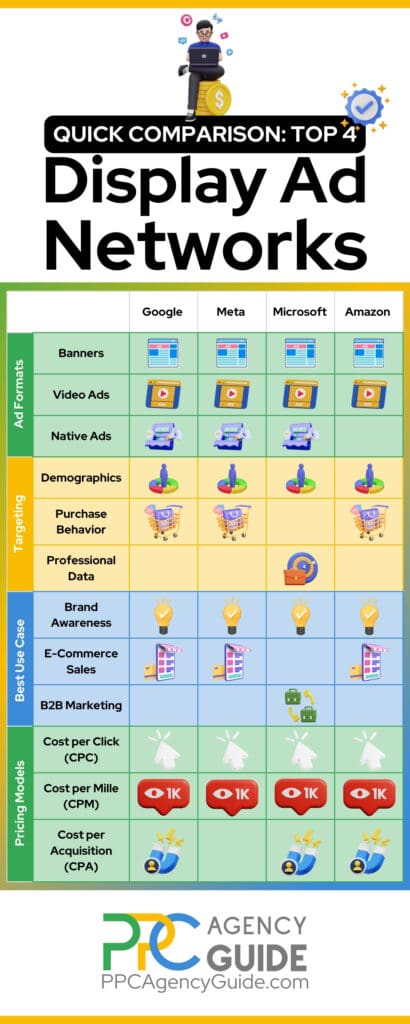
When it comes to display advertising, most people automatically think of Google—and for good reason. It’s massive, versatile, and powerful, making it a go-to option for advertisers around the world. But here’s the thing: while Google is a strong contender, it’s not always the best choice for every advertiser or every business need.
Other networks like Meta, Microsoft, and Amazon bring unique strengths to the table, offering specialized advantages for e-commerce sales, B2B leads, or building brand awareness. Understanding these differences is key to making a smarter choice and getting the most from your ad budget. Below, we’ll provide a detailed comparison of display ad networks so it’s easier to find the best fit for your business needs.
Display Advertising: A Brief Overview
Display advertising is a form of online advertising where your business’s ads appear on websites, apps, or social media platforms in various visual formats, such as banners, images, or even videos. Unlike search ads, which rely on keywords and search intent, display ads focus on grabbing attention with visuals and targeting users based on their online behavior, demographics, or interests.
For example, let’s say you run a transportation company. A display ad might feature an image of your fleet or highlight your on-time delivery guarantee, targeting businesses in your area that have recently searched for “freight services near me” or visited logistics-related websites. It helps you put your business in front of the right audience while they’re browsing online.
Benefits of Display Advertising
Display advertising offers a unique set of advantages for businesses, whether you’re just starting out or scaling up. Here’s why it could be a good fit for your marketing strategy.
Wide Reach
With display ads, you can reach millions of potential customers across the internet. For instance, Google Display Network (GDN) alone can connect your ads to over 35 million websites, apps, and YouTube videos, the platform reports.
Precise Targeting
Display ads allow you to target specific audiences. You can refine who sees your ads based on:
- Demographics: Age, gender, location.
- Interests: Like travelers, fitness enthusiasts, or tech-savvy shoppers.
- Behavior: Past purchases or website visits.
For instance, if you own a real estate business, you can target potential homebuyers browsing property listing sites or reading blogs about homebuying tips. Your ad might showcase a virtual tour of a newly listed property or highlight special financing options to attract their interest.
Cost-Effectiveness
Display ads often work on a pay-per-click (PPC) model, meaning you only pay when someone clicks your ad. For businesses on a budget, this ensures you’re spending on actual engagement rather than impressions.
How Display Ad Networks Work
A display ad network is like a matchmaking service for advertisers and publishers. It connects businesses (advertisers) looking to promote their products or services with websites, apps, and platforms (publishers) that have the right audience for their ads. Think of it as the behind-the-scenes system that makes sure your ads show up in the right places online. Here’s a step-by-step overview of the process.
Advertisers: Sharing Your Message
Advertisers like you kick off the process by creating campaigns designed to reach specific audiences. This involves:
- Visuals: Designing banners, videos, or other eye-catching ads.
- Targeting Criteria: Setting preferences like location, interests, and browsing behavior, such as recent searches for freight services or financial tools.
- Budget: Deciding how much to spend, whether per click (PPC) or per thousand impressions (CPM).
For example, a healthcare provider acting as an advertiser might create a campaign promoting seasonal flu shots to raise awareness ahead of flu season.
Publishers: Hosting Your Ads
Publishers, such as websites, apps, or platforms, partner with ad networks to sell space for ads. Their role includes:
- Ad Space: Offering placements for ads, like banners on blogs or pop-ups in apps.
- Formats: Hosting different types of ads, from static images to autoplay videos.
- Revenue: Earning income when ads are shown or clicked.
Using the healthcare provider example we discussed earlier, their ads might appear on health-related websites, which act as publishers by offering space for display ads. This ensures the campaign reaches an audience already interested in wellness topics.
The Ad Network: Making the Match
Ad networks act as the middleman, connecting your ads to the best available spaces using:
- Audience Data: Matching your targeting criteria with user demographics, interests, and behaviors.
- Context: Ensuring ads align with the content of the page or app they appear on.
- Optimization: Continuously improving placements for better results.
- Analogy: Think of the network as your matchmaker, ensuring your ads get in front of the perfect audience at the perfect time.
Real-Time Auctions: Winning the Spot
Every time someone visits a webpage or opens an app, the network holds an instant auction to determine which ad to show. This works through:
- Instant Bidding: Advertisers bid for the placement in real-time.
- Highest Bidder: The advertiser offering the best price or most relevant ad wins the spot.
- Efficiency: This ensures your ad budget is spent strategically.
Performance Tracking: Refining Your Ads
Once your campaign is live, tracking tools help you see how well it’s performing:
- Metrics: Analyze impressions, clicks, and conversions to gauge success.
- Adjustments: Refine targeting, visuals, or messaging based on the data.
- Insights: Learn from your results to optimize future campaigns.
For instance, a financial services company might notice higher engagement on ads promoting retirement planning tools and decide to shift its focus toward targeting individuals nearing retirement age.
Best Display Advertising Platforms Compared
Although there are countless display advertising platforms to explore, some of the most popular are Google Display Network, Meta Audience Network, Microsoft Audience Network, and Amazon. Below, we’ll explore what sets each one apart.
Google Display Network
The Google Display Network is one of the largest and most versatile ad networks, connecting advertisers to over 35 million websites, apps, and Google-owned platforms like YouTube and Gmail. It excels in broad reach and advanced targeting, making it ideal for building brand awareness and retargeting users.
Reach and Audience
- Audience Size: Over 90% of global internet users are reachable through GDN.
- Key Audiences: Consumers across all demographics, with strong potential for local and global campaigns.
GDN is ideal for reaching a broad or niche audience, whether you’re targeting millennials shopping online or retirees reading travel blogs.
Ad Formats
- Banners: Static or animated display ads.
- Responsive Display Ads: Ads that adjust automatically to fit available ad spaces.
- Video Ads: Short ads displayed on YouTube and partner sites.
- Interactive Ads: Engage users with clickable elements or gamified content.
Targeting Options
- Demographics: Age, gender, income, parental status.
- Interests: Users interested in topics like fitness, technology, or finance.
- Behavior: Website visits, app usage, or purchase history.
- Retargeting: Show ads to users who have interacted with your website or app.
- Optimized Targeting: Automatically expand your audience to include new users likely to convert, based on your existing campaign data.
Best Use Cases
- Brand Awareness: Launching a new product or service.
- Retargeting: Re-engaging users who didn’t convert.
- E-commerce: Driving traffic to an online store.
Pricing Model
- CPC (Cost Per Click): Pay only when users click your ad.
- CPM (Cost Per Thousand Impressions): Pay for ad views.
- CPA (Cost Per Acquisition): Pay for specific conversions, such as form submissions.
Budgets are flexible, accommodating both small businesses and large-scale advertisers.
Unique Features
- Responsive Ads: Simplify ad creation by uploading assets, and GDN automatically generates optimized ads.
- Remarketing Tools: Powerful retargeting options to reconnect with potential customers.
- Integration with Google Ads: Easy campaign management and performance tracking alongside search and video ads in the Google Ads platform.
Meta Audience Network
The Meta Audience Network allows advertisers to extend their campaigns beyond Meta’s platforms, reaching users across a diverse range of high-quality apps and websites. This network leverages Meta’s robust targeting capabilities to deliver ads to relevant audiences, enhancing brand visibility and engagement.
Reach and Audience
- Audience Size: The network encompasses a wide range of platforms, ensuring that your ads are displayed in a contextually relevant environment.
- Key Audiences: Users engaged in various apps and websites, including news platforms like BuzzFeed, entertainment platforms such as Sega, game platforms like Mobage, and utility apps including Tabelog.
Ad Formats
- Native Ads: Seamlessly integrated into the app’s content, providing a non-intrusive user experience.
- Banner Ads: Displayed at the top or bottom of the app interface.
- Interstitial Ads: Full-screen ads that appear at natural transition points within the app.
- Rewarded Video Ads: Users can choose to watch a video ad in exchange for in-app rewards.
Targeting Options
- Demographics: Age, gender, location, and language.
- Interests: Based on user activities and preferences across Meta platforms.
- Behaviors: Purchase history, device usage, and other user behaviors.
- Custom Audiences: Target users who have previously interacted with your business.
- Lookalike Audiences: Each new person is similar to your existing customers by leveraging a source audience. You can define how closely this audience matches your source by using a percentage range (smaller percentages = closer match, larger percentages = broader reach). Note: Lookalike Audiences exclude users in the source audience and require at least 100 users from a single country to create.
Best Use Cases
- Brand Awareness: Expanding reach to new audiences beyond Meta platforms.
- App Installs: Promoting mobile apps to users engaged in similar app environments.
- Engagement: Driving interactions with interactive ad formats like rewarded videos.
Pricing Model
- CPC (Cost Per Click): Pay when users click on your ad.
- CPM (Cost Per Thousand Impressions): Pay for every thousand times your ad is shown.
- CPA (Cost Per Action): Pay when a user takes a specific action, such as installing an app.
Meta Audience Network utilizes the same auction and delivery systems as Facebook ads, providing a seamless experience for advertisers.
Unique Features
- Extended Reach: Access to a vast network of apps and websites, increasing ad exposure.
- Consistent Targeting: Utilizes Meta’s advanced targeting capabilities across external platforms.
- Seamless Integration: Ads are designed to fit naturally within the app environment, enhancing user experience.
Microsoft Audience Network
The Microsoft Audience Network (MSAN) is a native advertising solution that enables advertisers to reach a broad audience through Microsoft’s premium properties, including MSN, Outlook.com, Microsoft Edge, and select partner sites. Powered by artificial intelligence and rich user intent data, MSAN delivers highly relevant ads to users, enhancing engagement and conversion rates.
Reach and Audience
- Audience Size: MSAN reaches over half a billion people worldwide, providing substantial scale for advertisers.
- Key Audiences: The network encompasses a diverse user base, including professionals, decision-makers, and consumers across various demographics and interests. Notably, MSAN integrates LinkedIn profile targeting, allowing advertisers to reach users based on their industry, job function, and company.
Ad Formats
- Image-Based Ads: Visually engaging ads that blend seamlessly with content across Microsoft’s properties.
- Text Ads: Contextually relevant ads displayed alongside search results and content.
- Feed-Based Ads: Dynamic ads generated from product feeds, are ideal for promoting a range of products or services.
Targeting Options
- Demographics: Target users based on age, gender, location, and device.
- In-Market Audiences: Reach users who are actively searching for products or services similar to yours.
- Custom Audiences: Utilize your own customer data to target specific user segments.
- LinkedIn Profile Targeting: Leverage LinkedIn data to target users by industry, job function, and company, providing a unique advantage for B2B advertisers.
Best Use Cases
- Brand Awareness: Expanding reach to a broad and diverse audience across premium properties.
- Lead Generation: Utilizing LinkedIn profile targeting to reach professionals and decision-makers.
- E-commerce: Promoting products through dynamic feed-based ads to users with demonstrated purchase intent.
Pricing Model
- CPC (Cost Per Click): Pay when users click on your ad.
- CPM (Cost Per Thousand Impressions): Pay for every thousand times your ad is shown.
- CPA (Cost Per Acquisition): Pay when a user completes a specific action, such as a purchase or sign-up.
MSAN offers flexible budgeting options, accommodating both small businesses and large enterprises.
Unique Features
- LinkedIn Integration: Exclusive access to LinkedIn profile data for precise B2B targeting.
- AI-Powered Optimization: Utilizes artificial intelligence to enhance ad relevance and performance.
- Premium Inventory: Ads appear on high-quality Microsoft properties, ensuring brand safety and visibility.
Amazon Advertising
Amazon Advertising offers a suite of tools designed to help businesses increase visibility and drive sales by reaching customers on Amazon’s platform and its affiliated sites. Leveraging Amazon’s vast customer data, advertisers can target audiences based on shopping behaviors, interests, and demographics, ensuring ads are displayed to relevant users.
Reach and Audience
- Audience Size: Amazon boasts over 300 million active customer accounts worldwide, providing advertisers with access to a vast and diverse user base, the company reports.
- Key Audiences: Consumers actively searching for products, making purchase decisions, and engaging with content across Amazon’s platforms, including Amazon.com, IMDb, and Fire TV.
Ad Formats
- Sponsored Products: Cost-per-click (CPC) ads promoting individual product listings, appearing in search results and product detail pages.
- Sponsored Brands: CPC ads featuring a brand logo, custom headline, and multiple products, displayed in search results to boost brand visibility.
- Sponsored Display: Display ads targeting relevant audiences on and off Amazon, utilizing shopping signals to reach potential customers.
- Video Ads: Engaging video content showcased across Amazon sites, devices, and third-party platforms to capture audience attention.
- Audio Ads: Ads played on Amazon Music’s free tier, reaching listeners with non-visual content.
Targeting Options
- Demographics: Target users based on age, gender, income, and more.
- Interests: Reach audiences with specific interests, such as fitness enthusiasts or tech aficionados.
- Behavioral Targeting: Utilize shopping behaviors, including past purchases and browsing history, to reach relevant customers.
- Contextual Targeting: Place ads on pages with content related to your products or services.
- Remarketing: Re-engage users who have previously viewed your products or similar items.
Best Use Cases
- E-commerce: Ideal for retailers aiming to increase product visibility and drive sales directly on Amazon.
- Brand Awareness: Utilize Sponsored Brands and Video Ads to enhance brand recognition among Amazon’s vast user base.
- Product Launches: Leverage Amazon’s targeting capabilities to introduce new products to interested consumers.
Pricing Model
- Cost-Per-Click (CPC): Pay when users click on your Sponsored Products, Sponsored Brands, or Sponsored Display ads.
- Cost-Per-Thousand Impressions (CPM): Pay per thousand impressions for display and video ads.
- Cost-Per-Mille (CPM): Audio ads are sold on a CPM basis, paying per thousand impressions.
Amazon Advertising offers flexible budgeting options, accommodating businesses of all sizes.
Unique Features
- Access to Purchase Data: Leverage insights from Amazon’s vast customer purchase history to inform targeting strategies.
- Seamless Shopping Experience: Ads are integrated into the shopping journey, allowing users to discover and purchase products effortlessly.
- Amazon DSP: A demand-side platform enabling programmatic ad buying across Amazon sites and third-party exchanges.
Choosing a Display Ad Network
Selecting the right display network is a critical step in crafting a successful advertising strategy. Each network offers unique advantages, so your choice should align with your business goals, target audience, and budget. Here’s how to evaluate your options.

Understand Your Goals
The first step is knowing what you want to achieve with your display ads. Different networks are suited for different objectives:
- Brand Awareness: If your goal is broad visibility, networks like Google Display Network or Meta Audience Network offer extensive reach.
- Lead Generation: Platforms with strong targeting capabilities, like Microsoft Audience Network, excel at finding high-value prospects.
- Sales: Amazon Advertising is ideal for e-commerce businesses aiming to convert browsing into buying.
Identify Your Target Audience
Each display network attracts different types of users. Ask yourself the following questions.
Where is your audience spending time?
Meta Audience Network reaches social media and app users, while Microsoft Audience Network targets professionals and decision-makers, and Amazon Advertising connects with active shoppers.
How specific are your targeting needs?
Networks like Google and Meta excel in demographic, behavioral, and interest-based targeting, while Microsoft adds a unique edge with LinkedIn profile targeting.
Compare Ad Formats
Ad formats vary across networks, and your choice should match the type of content you want to promote:
- Visuals: GDN and Meta support a wide range of banners, videos, and interactive ads.
- Video: Meta and Amazon excel with engaging video ad placements.
- Native Ads: Microsoft offers native formats that blend seamlessly with content, which is ideal for non-disruptive advertising.
Evaluate Costs and Pricing Models
Different networks operate with distinct pricing structures, so understanding these is crucial:
- Budget Flexibility: GDN and Meta cater to businesses of all sizes with scalable budgets.
- CPC vs. CPM: Know whether you’re paying for clicks (CPC) or impressions (CPM).
- Return on Investment (ROI): Amazon excels in direct sales, while Microsoft often provides a higher ROI for B2B campaigns.
Consider Unique Features
What sets each network apart may help you make your final decision:
- Google Display Network: Massive reach and robust remarketing tools.
- Meta Audience Network: Deep integration with Meta platforms and interactive ad formats.
- Microsoft Audience Network: LinkedIn profile targeting for precise B2B marketing.
- Amazon Advertising: Access to purchase intent data for high-conversion e-commerce campaigns.
Test and Adjust
It’s often wise to start small and run test campaigns on multiple networks. Compare performance metrics like click-through rates (CTR), cost-per-click (CPC), and conversion rates to see which network aligns best with your business needs.
Grow Your Business with Professional Display Ad Campaigns
Choosing the right display network isn’t about finding the “best” platform. It’s about finding the one that best suits your audience, goals, and resources. By aligning these factors, you’ll maximize your ad spend and achieve meaningful results. This may mean working with a single display ad network or spreading your budget across several. An experienced PPC agency can help you navigate these choices, ensuring every dollar is spent strategically and your campaigns deliver measurable results. To get started, request a complimentary consultation.

Display Ad Networks Comparison FAQs
Which display ad network is best for e-commerce businesses?
Amazon Advertising is ideal for e-commerce due to its access to active shoppers and purchase intent data. Google Display Network also excels with broad reach and retargeting options, while Meta Audience Network offers highly engaging ad formats that work well for driving product discovery and sales.
What’s the difference between Google Display Network and Meta Audience Network?
Google Display Network offers extensive reach with over 35 million sites and apps, robust remarketing, and a variety of ad formats. Meta Audience Network extends Facebook and Instagram campaigns to external apps and sites, focusing on engaging, personalized ads that leverage Meta’s deep targeting capabilities.
Can I run display ads on multiple networks at the same time?
Yes, running ads across multiple networks can help broaden reach and diversify results. For example, you can use Google Display Network for wide exposure, Meta for social engagement, and Amazon for targeting shoppers. Monitoring performance on each platform ensures your budget is optimized.
What targeting options are available on display ad networks?
Common targeting options include demographics (age, gender, location), interests, purchase behavior, and retargeting. Some networks, like Microsoft Audience Network, offer unique options like LinkedIn profile targeting for B2B campaigns, while others focus on consumer shopping signals.
How do I choose the right display ad network for my business?
Start by identifying your goals (e.g., brand awareness, e-commerce sales, or B2B leads). Then, evaluate each network's strengths. For example, Amazon excels in e-commerce, Microsoft is great for B2B, and Google provides massive reach. Test and refine campaigns as needed.
What’s the difference between CPC, CPM, and CPA pricing models for display ads?
- CPC (Cost Per Click): Pay when someone clicks your ad.
- CPM (Cost Per Mille): Pay for every 1,000 impressions (ad views).
- CPA (Cost Per Acquisition): Pay only when a user completes a specific action, like a purchase or form submission.
Is the Microsoft Audience Network good for B2B marketing?
Yes, Microsoft Audience Network is excellent for B2B marketing. Its integration with LinkedIn allows precise targeting based on job titles, industries, and company size, making it ideal for reaching decision-makers and professionals.
How does Amazon Advertising help e-commerce businesses grow?
Amazon Advertising reaches active shoppers by leveraging purchase intent data. Sponsored Products, Sponsored Brands, and display ads drive visibility and conversions directly on Amazon’s platform, making it a powerful tool for increasing e-commerce sales.
Are display ad campaigns effective for brand awareness?
Yes, display ads are highly effective for building brand awareness. Networks like Google and Meta offer extensive reach and engaging formats, helping businesses stay top-of-mind with their target audience. Consistent visibility increases brand recognition over time.


















